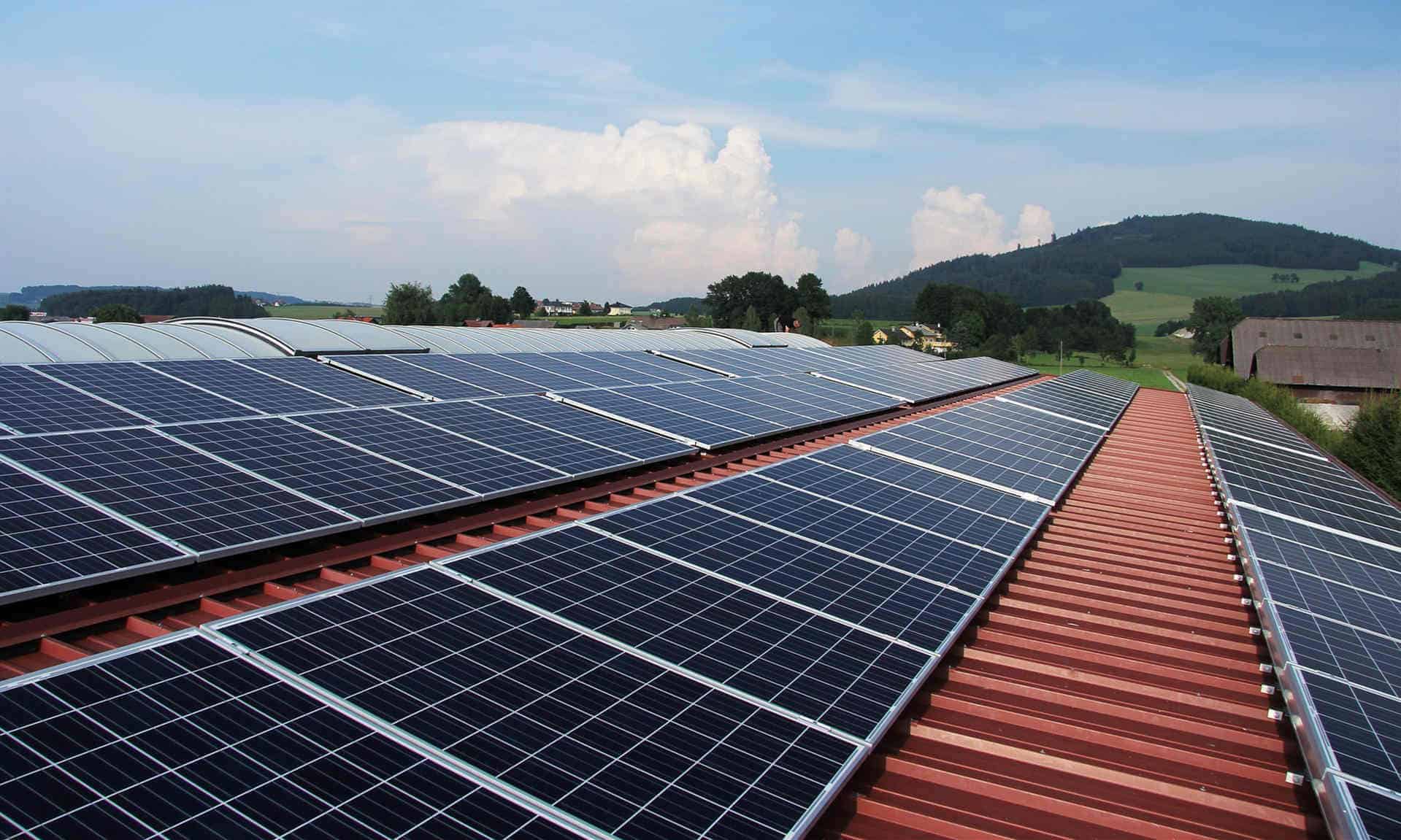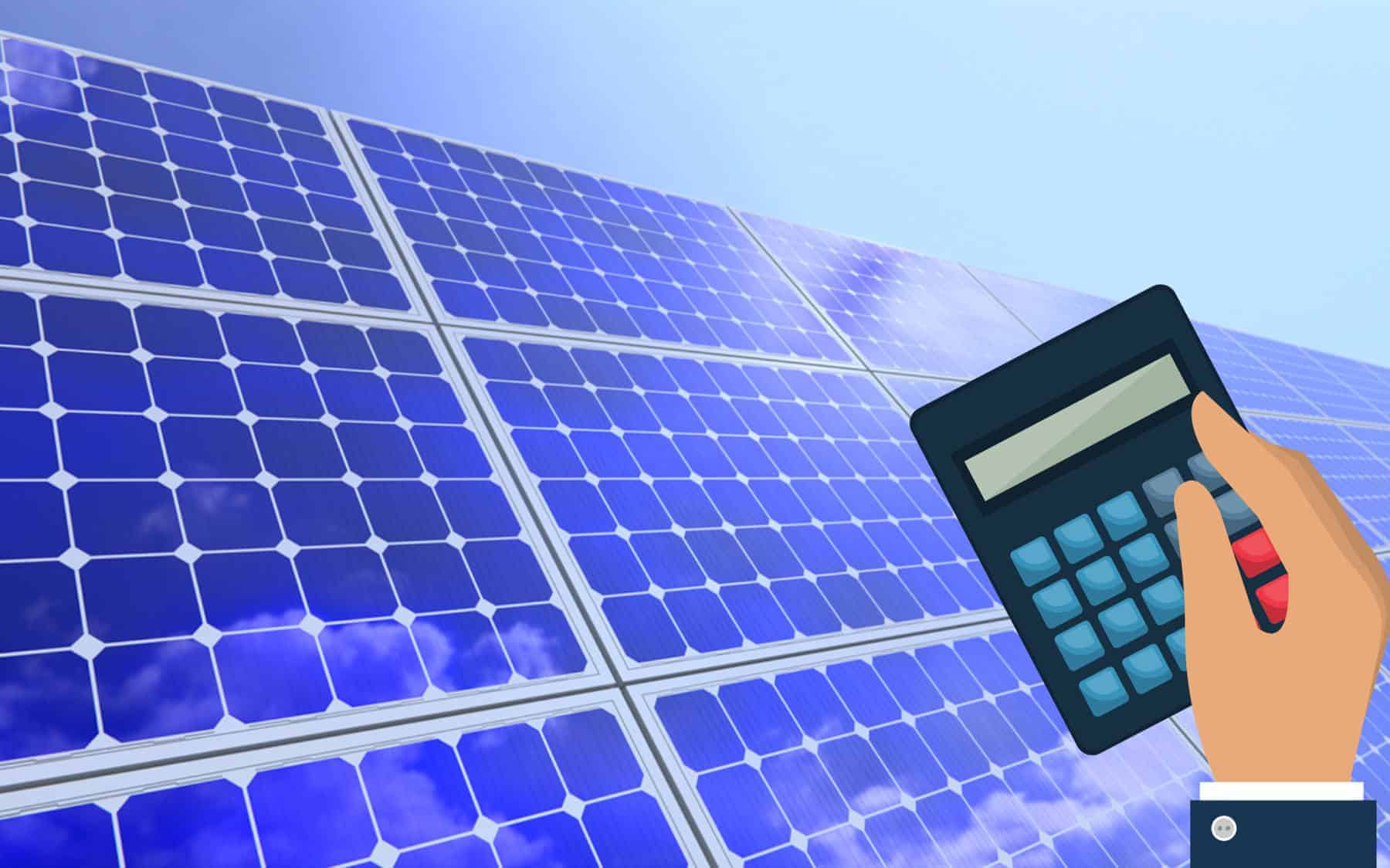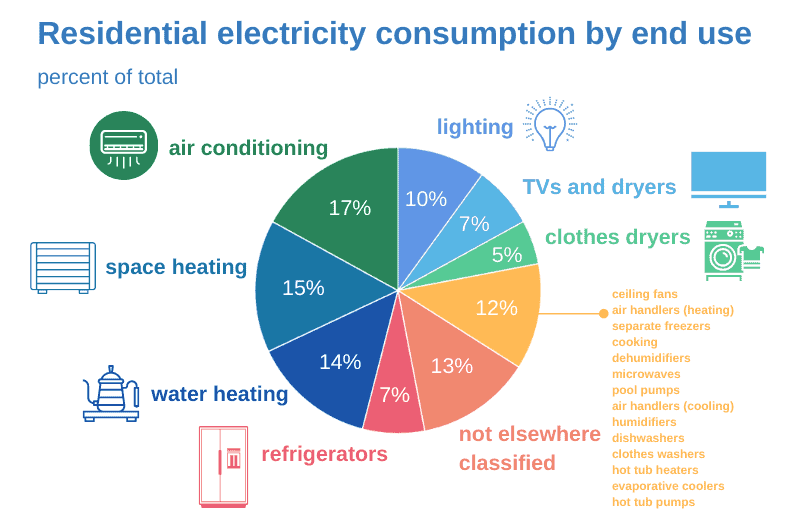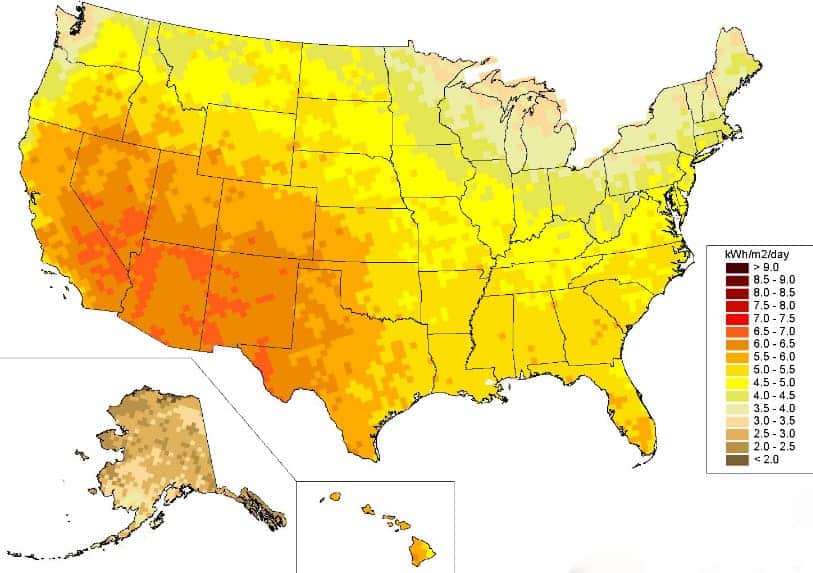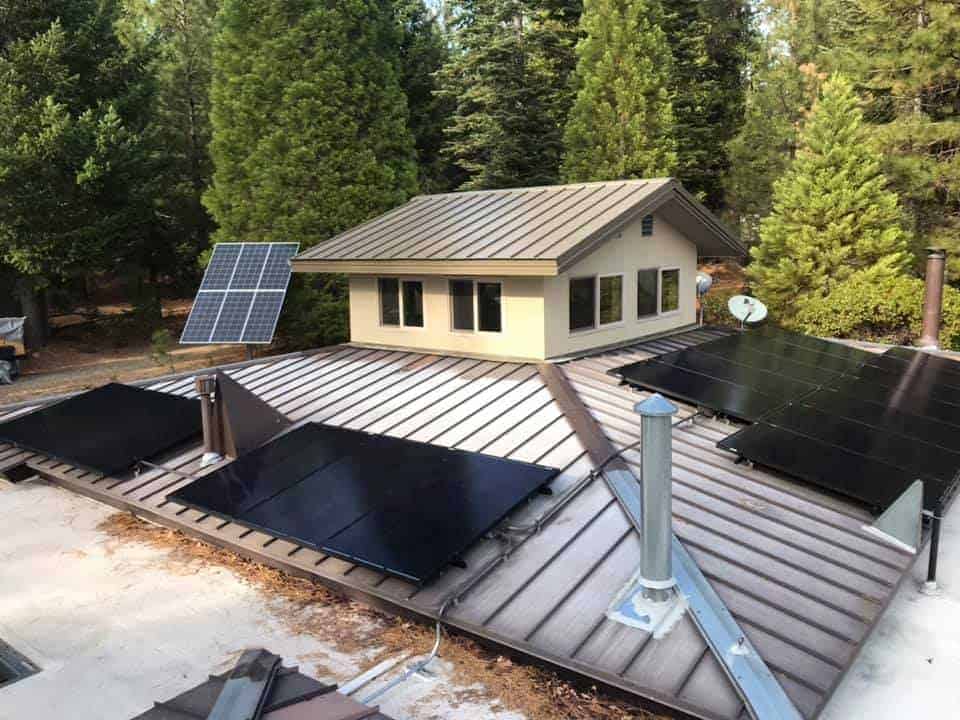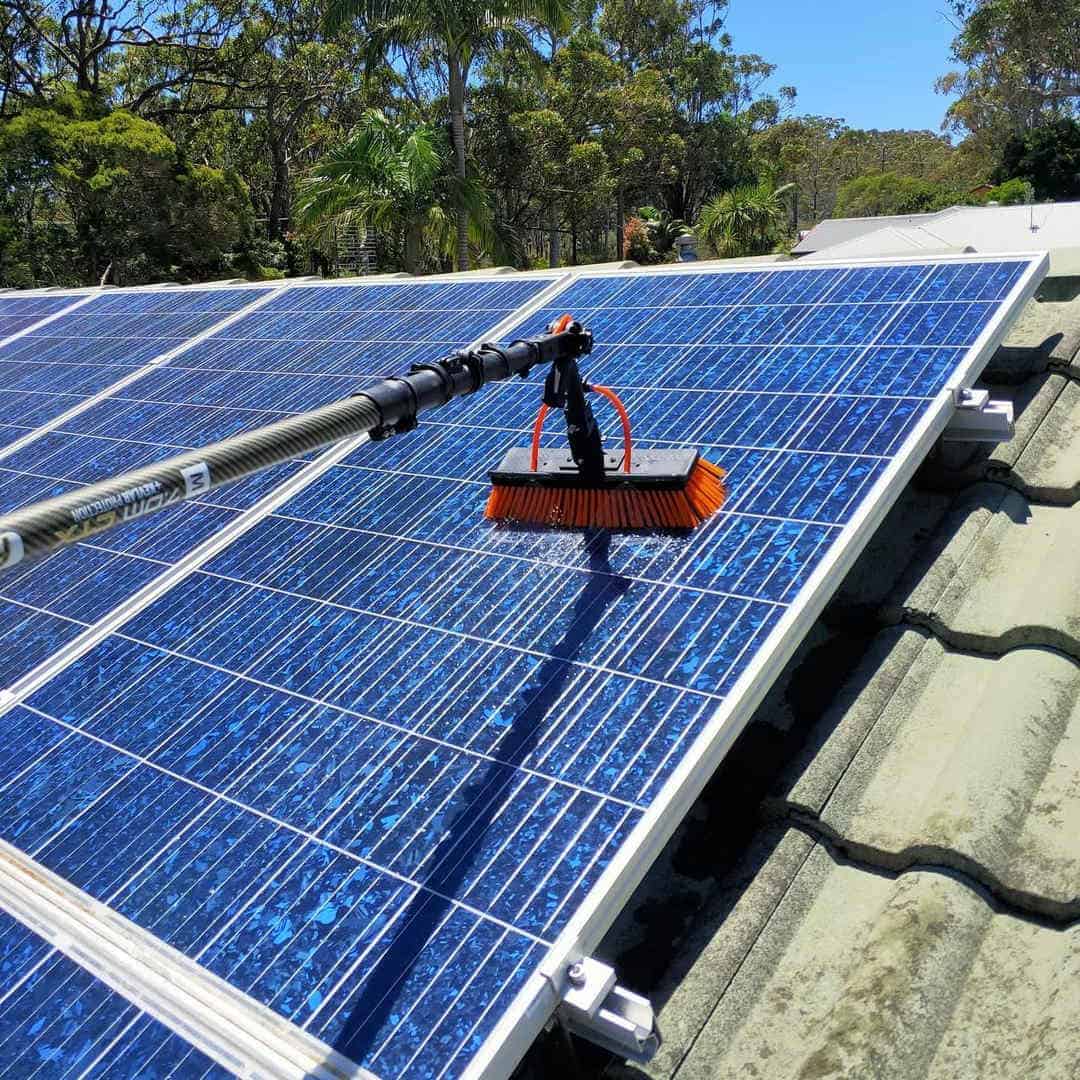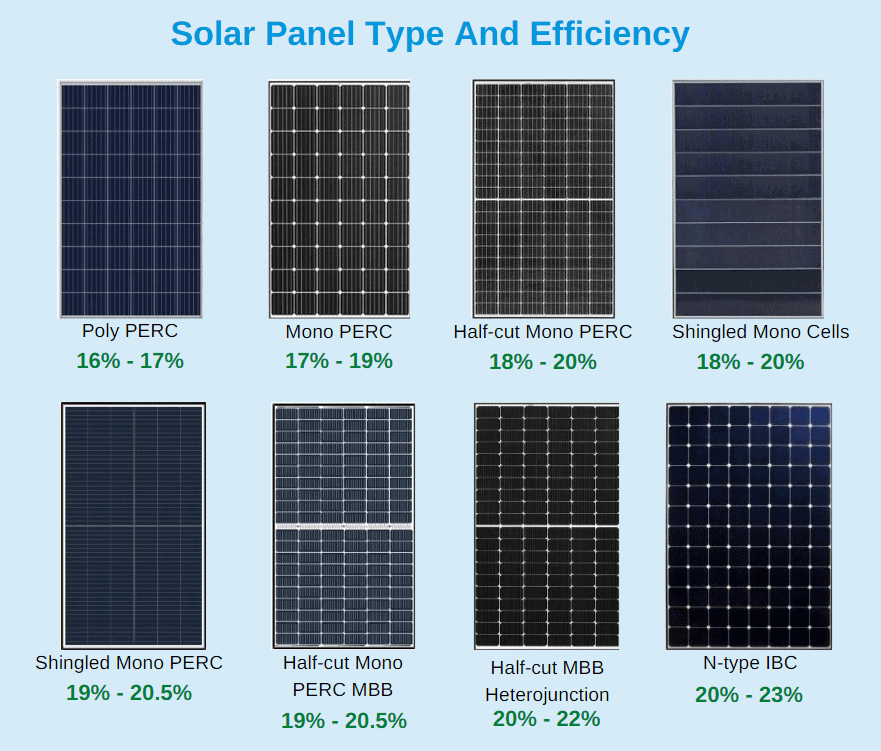Are you thinking of installing solar panels? I know that I am. They are a great way to save on electricity bills while helping the environment. You’re saving money and helping the climate; it’s the best of both worlds!
But there’s a lot of research to do to make sure that you’re installing a solar setup that generates enough power to make the whole thing worth your while. I’ve studied everything in detail, so let me save you the trouble.
So, just how much energy do solar panels produce?
How to Understand All The Numbers and Symbols
Figuring out how much power you’re going to get from your solar panel is actually a lot simpler than you might think.
Solar panels are rated by their power output capacity in Watts (W for short).
Typically, domestic solar panels produce a power output of between 250 and 400 Watts.
Kilowatt (KW) is just another name for 1,000 Watts.
We measure the energy a solar panel produces in Kilowatt Hours (kWh).
So if you have a 250 W solar panel that gets the equivalent of four hours of direct sunlight a day, it produces 1 kWh of energy (4 x 250 = 1,000).
And then if you multiply your average daily power output by 365 (or 366 on a leap year!), you have your annual solar power output. In the example I used above, the yearly energy production would be 1 kWh * 365 = 365 kWh.
Here’s that calculation again:
Solar Panel Power in Kilowatts x Average Sunlight Hours Per Day x 365 = Annual Power in Kilowatt Hours (kWh)
And that’s it for the math.
The problem I have with all of this is that these numbers don’t mean much to me until I translate them into actual energy usage. Why don’t we take a look at what these Kilowatt Hours of energy mean to you and your electricity bill?
Can I Power My Whole Home With Solar Panels?
Statistics from the U.S. Energy Information Administration show that in 2019 the average energy usage per U.S. household was 10,649 kWh, which is around 29 kWh a day. Remember that this is a ballpark figure, and your energy usage may be higher or lower. If you look at your electricity bills for a full year then you can calculate precisely how much energy your household uses.
The big-ticket items in terms of electrical usage have to do with heating and cooling. More than 50% of domestic electricity usage comes from aircon, home heating, water heaters, and refrigerators. If you use a lot of these, then you’re likely to have a higher energy requirement than the national average.
If you were to install solar panels with a combined power of 5 kW in an area that receives, on average, four hours of direct sunlight a day, then your annual solar energy production would be 7,300 kWh. That’s 69% of an average household’s annual energy needs – very handy indeed.
So it is possible to meet most or even all of your power needs from solar power, provided you have enough roof space and the funds for an extensive system.
Let’s take a look at how achievable those solar power energy returns are for you.
Is Geographical Location a Factor?
Location, location, location. The effectiveness of solar panels is strongly influenced by where you live. The US states with the most sunshine and the clearest skies are the best places to install solar panels. But that doesn’t mean that you can’t get good returns in other states.
Studies show that the most productive states in terms of the energy collected by solar panels are Arizona and New Mexico. In these states, a 1 kW solar setup will generate nearly 5 kWh of power per day on average. But if you install the same panels in Washington State, you can expect just 3 kWh per day and only 2.8 in Minnesota.
Wherever you live, you can use solar panels to make a real difference in your energy costs.
If you’re in a cloudier, more northern state with less direct sunlight, you may need to install more panels to achieve the desired energy output.
This is because in places with less direct sunlight, you need to spend more money on a larger solar panel set up to get the same energy you’d get from a small setup in a sunnier place.
Solar power is more economical in places with a lot of direct sunlight.
Average Annual Sunshine by State
Total Hours is the average sunny hours during the year.
Clear Days are the average number of days annually when cloud cover doesn’t exceed 30% during the daytime.
|
State |
Total Hours |
Clear Days |
Average Annual Sunshine (kJ/m²) |
|
Alabama |
2641 |
99 |
4660 |
|
Arizona |
3872 |
211 |
5755 |
|
Arkansas |
2771 |
123 |
4724 |
|
California |
3055 |
146 |
5050 |
|
Colorado |
3107 |
115 |
4960 |
|
Connecticut |
2585 |
82 |
3988 |
|
Delaware |
2618 |
97 |
4232 |
|
Florida |
2927 |
101 |
4859 |
|
Georgia |
2986 |
112 |
4661 |
|
Idaho |
2993 |
120 |
4251 |
|
Illinois |
2567 |
95 |
4380 |
|
Indiana |
2440 |
88 |
4318 |
|
Iowa |
2691 |
105 |
4331 |
|
Kansas |
2922 |
128 |
4890 |
|
Kentucky |
2514 |
93 |
4383 |
|
Louisiana |
2649 |
101 |
4725 |
|
Maine |
2513 |
101 |
3815 |
|
Maryland |
2582 |
105 |
4267 |
|
Massachusetts |
2634 |
98 |
3944 |
|
Michigan |
2392 |
71 |
4018 |
|
Minnesota |
2711 |
95 |
3968 |
|
Mississippi |
2720 |
111 |
4693 |
|
Missouri |
2690 |
115 |
4545 |
|
Montana |
2698 |
82 |
3847 |
|
Nebraska |
2762 |
117 |
4685 |
|
Nevada |
3646 |
158 |
5296 |
|
New Hampshire |
2519 |
90 |
3891 |
|
New Jersey |
2499 |
94 |
4056 |
|
New Mexico |
3415 |
167 |
5642 |
|
New York |
2120 |
63 |
3904 |
|
North Carolina |
2651 |
109 |
4466 |
|
North Dakota |
2738 |
93 |
3925 |
|
Ohio |
2183 |
72 |
4139 |
|
Oklahoma |
3089 |
139 |
4912 |
|
Oregon |
2341 |
68 |
3830 |
|
Pennsylvania |
2614 |
87 |
3939 |
|
Rhode Island |
2606 |
98 |
3989 |
|
South Carolina |
2826 |
115 |
4624 |
|
South Dakota |
2947 |
104 |
4332 |
|
Tennessee |
2510 |
102 |
4486 |
|
Texas |
2850 |
135 |
5137 |
|
Utah |
3029 |
125 |
4887 |
|
Vermont |
2295 |
58 |
3826 |
|
Virginia |
2829 |
100 |
4354 |
|
Washington |
2170 |
58 |
3467 |
|
West Virginia |
2358 |
60 |
4146 |
|
Wisconsin |
2428 |
89 |
4023 |
|
Wyoming |
3073 |
114 |
4471 |
Does It Matter Where I Put The Panels?
It matters very much where you place your solar panels. In the northern hemisphere, the most effective solar panel location is on a south-facing roof, so if you have one, this is ideal. The object of this positioning is to get this solar panel placed so that it gets maximum exposure to the sun which tracks across the sky to the South.
Another factor in the efficiency of a solar panel is the angle at which you place it. The aim here is to make sure the solar panels face the daytime sun as directly as possible. This positioning allows the panels to absorb the maximum energy from sunlight. If photons from the sun hit a solar panel at an oblique angle, fewer are absorbed and less power is produced.
The better the solar panel is positioned and angled, the more precious energy it absorbs. Any solar company worth its salt will be able to advise you on the best positioning for your solar panel setup. Still, it’s helpful to understand the basic principles when deciding on the location of your solar array.
Other Factors That Affect Solar Energy Production
Solar panels need to be clean to work well since dust, bird droppings, and anything else that gets them dirty will reduce their ability to absorb sunlight and convert it into power. This is where rain can help since rainfall is an excellent natural cleaner for solar panels. Turns out there are advantages to living somewhere wet.
If you’re in an especially dry state, or it hasn’t rained for a long time, then it’s a good idea to make sure that you keep solar panels clean to keep them working at their best.
How Important Is Solar Panel Efficiency?
Some solar panels are more efficient than others. This means that they can generate the same Wattage of power as a less efficient panel that takes up a larger area. More efficient systems are often a lot more expensive than standard solar panels. So you need to decide if you need this extra expense.
It all comes down to space. If you have a large roof space to use for solar panels, then it makes sense for you to buy cheaper panels that generate the same amount of energy as a smaller, more expensive, efficient setup.
The key takeaway here is that an efficient 300 Watt panel doesn’t produce any more power than a less efficient 300 Watt panel; it just takes up less space.
If roof space isn’t an issue, you don’t need to worry as much about how much energy your solar panels produce.
Solar panels are given a percentage efficiency rating, usually in the range of 15-22%
You can use this efficiency rating to help you decide if you need more efficient, more expensive panels. Just calculate the maximum space that you want to make available for solar panels and then move on to how much power you want to generate from the system.
How Much Power Can I Generate From Solar Panels?
Calculating exactly how much power you can generate from solar panels is pretty complicated, so why not let somebody else do it for you? There are some good online sites where you simply enter a few details, and they make the calculation for you.
The results won’t be precise, but they will give you good ballpark figures to help you move forward in looking at solar panel systems. By the time it comes to going through the details with one, or better, more, solar contractors, you will have a pretty clear idea of what you’re looking for.
Are you interested in finding out how much energy you can generate from solar panels on your roof? Use a free online calculator today – enter your roof size to receive a free estimation.
Conclusion
So now we know the factors that affect how much energy solar panels produce. Some of these factors are out of our control. We can’t (unfortunately) change the weather where we live. But there are several things that we can to make sure that we get a solar panel system that provides all the energy we want.
Here’s a quick checklist reminding you how to get an energy return from your solar system that meets your needs.
- Calculate your total energy usage.
- Work out how much roof or other space you can give over to solar panels.
- Calculate how much direct sunlight there is in your area.
- Work out the maximum energy production you can get from the space you have using efficient and less-efficient panels.
- Check out the purchase costs, subtracting any government incentives that are available to you.
- Order a solar panel system that gives you the energy savings you’re looking for.

